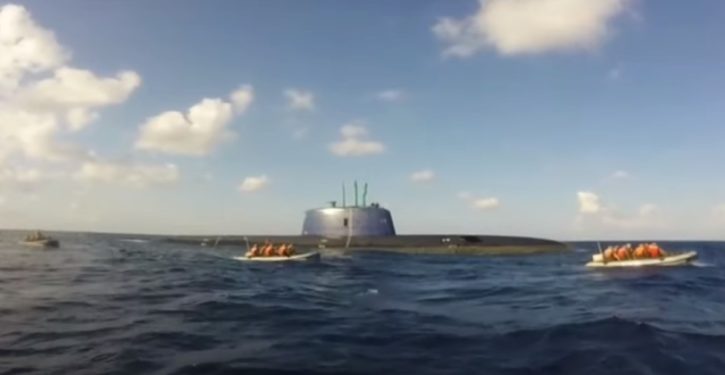The game has changed. The sense of that came home this week with a very informative sequence of events surrounding the re-initiation of “U.S.-Iran talks” (such as they are) and the attack on an Iranian “mother ship” supporting special operations in the Red Sea. attack on the Saviz
The developments occurred simultaneously, for all intents and purposes. It was pretty clear they are tied together. What’s equally important is that in their nature, they are of a piece with the other major developments in global geopolitics: the Russian build-up on Ukraine’s border and China’s very purposeful bustling around Taiwan.

BOGSAT with chandelier. Iran “deal” talks stagger to be born in Vienna. YouTube video
To put it in today’s vernacular, what these developments have in common is that things are “getting real.”
The Iran-U.S.-Israel dynamic is not “part of” the Russia-Ukraine and China-Taiwan scenarios, in any except a sense of expectations about U.S. behavior. Don’t look for “linkage” in terms of geopolitical details.
But the posture of the Biden administration in one situation is and will be seen as a guide to its likely posture and responses in the others. And the Biden posture has been established right out of the starting gate in the U.S.-Iran parley. It has been made clear in several ways. One of them is the Biden response as Iran blatantly violates sanctions on her oil trade and ships oil from Iran to Syria.
The Biden administration affects to be studying which sanctions to lift on Iran. But the administration is already failing to enforce sanctions on the oil shipments involving Syria.
Pre-messaging
In conjunction with that failure, Israel has reportedly been finding ways to sabotage Iranian shipping. If Haaretz is correct, this has been going on for some time (the last three years, according to the Israeli outlet).
But the way we’ve at last come to know that looks very much like an ancillary but extremely important aspect of the Biden posture: leaking information about Israel’s covert efforts to the media. The Trump administration did not leak information about it. Indeed, we can probably assume with some confidence that Trump was happy to have Israel sabotaging Iran’s sanctions-violating oil shipments. If Israel undertook that effort, the U.S. could focus elsewhere.
There is no reason to doubt where the leaks are coming from. If Israel’s secrets were being kept, the Israelis would have no incentive to leak such information themselves. Thwarting Iran’s ability to gain cash and empower Hezbollah and the Assad regime is too important to strategic priorities in Jerusalem. There’s nothing to be gained by outing their own secrets in that regard.
The Biden administration, however, is staffed by a host of characters from the Obama years who once ran a cottage industry of leaks about Israel in their spare time. It is no stretch to postulate that they’re doing it again.
The message they send with such leaks is a stark one. It’s not just that they are failing to be protective of Israel’s secrets. It’s that in their zeal to assure Iran of America’s cooperative attitude, they are going out of their way to disavow loyalty to the closest of allies. They’re signaling to the world that they have no intention of standing by Israel on this matter.
Anyone who thinks a nation can pick and choose where it will act in bad faith and not have all its credibility called into question is living in fantasyland.
If we work from that assumption, a news nugget from the past week makes sense, where it otherwise wouldn’t. According to the New York Times, Israel told the U.S. that Israeli forces had attacked the Iranian mother ship, the Saviz, in the Red Sea.

Iranian cargo ship Saviz. Via Maritime Telegraph
And NYT then heard about that from a U.S. official.
Many observers have been understandably indignant about U.S. officials informing the media of this. The presumption would be that Israelis told Americans such a thing in confidence, and earnest critics want the Biden administration to rethink its leaking.
It appears Haaretz is trying to extend the expiration date of that old mindset with a completely unsourced report on 9 April that an unspecified person had planned, improbably, to tell “foreign media” about the attack, but jumped the gun because the attack on Saviz was delayed by a day. We are to understand that this person wasn’t aware the delay had been decided on. This very peculiar “disclosure” doesn’t seem to account for something anyone actually realized; it was not obvious whether the U.S. had been informed in advance. The report seems only like a pro forma attempt to paper over a telling episode.
In any case, after the initial breach of Israel’s confidence, in the leaks prior to the attack on Saviz, the Israelis probably weren’t in any doubt as to where the leaks were coming from.
By contrast to the weird Haaretz story, it actually makes sense to conclude the Israelis knew what would happen when they told Biden administration officials they had attacked Saviz (or were going to). They were basically counting on Team Biden to make the information public.
Not everyone will be prepared to go with this hypothesis, at least not immediately. I wasn’t that sure myself until I discovered an excellent graphic from Twitter user PutinIsAVirus (hey, I don’t name ’em), who used satellite imagery in which user OSINT-1 had identified two submarine detections in the Red Sea in the days just before the attack on Saviz.
Propelled by @OSINT_1 spotting of a potential submarine in the Red Sea, here a fast #OSINT investigation into the potential use by #Israel of a submarine in the attack to #Iran vessel SAVIZ. (WARNING: many assumptions) @osinteditor pic.twitter.com/aQbDlRiqbb
— Putin is a Virus (@PutinIsAVirus) April 8, 2021
The minute I saw those, it was obvious this was a submarine that, at the very least, didn’t mind being seen.
There’s some due diligence to do on whether the sub could have readily avoided detection, and we’ll look at that in a moment. But the submarine being caught twice in satellite imagery (and the Israelis are well aware of when the imaging satellites get their “looks” every day) comports with an Israeli “information” posture of emphasizing their force presence and intention.
It fits and not only with a disclosure to the U.S. about the attack on Saviz that Israel then expects the Biden team to broadcast.
It also harked back to the unusual movement of the Israeli Dolphin submarine through the Suez Canal in December 2020, a transit the IDF has not publicly addressed but equally was willing to execute overtly and has made no attempt to be cagey about in the months since. The Dolphin has been seen multiple times in Eilat since then, as noted by PutinIsAVirus. Israel apparently wants it to be clear there’s a sub in the Red Sea.
Submarine’s choice
The sub imaged underway in the Red Sea does look like a Dolphin, to begin with. It has the shorter, fat-cigar-shaped aspect of a Dolphin (as opposed to other subs it might conceivably be, such as nuclear-powered attack submarines of the U.S. or French navies). The length of the sail versus the apparent overall length of the sub looks like a Dolphin.
What principally strikes me is how shallow the sub is operating in both detections. We can’t know if it was operating at shallow depth during the entire putative transit south through the Red Sea. My guess would be that it was not. But at the two times, it was captured by satellite imagery, it was quite shallow.
It also has a substantial wake behind it, indicating relatively robust speed and a lack of concern to prevent a detectable wake that could be observed by local surface traffic.
In each detected position, there’s plenty of depth under the keel for the sub to submerge much further. The first graphic shows there are easily some 500 meters or about 1,640 feet, give or take, in the detected locations. (As shown by the annotation to the depth legend on the left, diesel-powered attack subs like the Dolphin will typically prefer to operate with at least 40 meters under the keel.) There is no lack of depth where a sub is likely to transit in the Red Sea; this one could have submerged to a depth at which a satellite would have little chance of discerning it – and could have moved at a slower speed and minimized its wake.

Relevant context for assessing environmental constraints versus sub operating profile. Click to enlarge for legibility. Graphic credits: Center, detail from @PutinIsAVirus graphic, Twitter. L/R: ResearchGate; Remote Sensing the Phytoplankton Seasonal Succession of the Red Sea (paper). https://www.researchgate.net/publication/237098569_Remote_Sensing_the_Phytoplankton_Seasonal_Succession_of_the_Red_Sea?_sg=lyKKs49cb16AvBH1DS_Tf4OfS1oiLTp674MueoXe94-Lytz-pw4E5l4hTMMNCsNVTxiS8tBJVg. Adapted; author annotation
It’s also quite interesting to note that both satellite detections caught the sub in a very similar position relative to a pair of “cold eddies” (the cyclonic-motion, or counter-clockwise eddies) that persist in the Red Sea throughout the year. See the map on the right in the first graphic.
The cold eddies create natural barriers to good acoustic transmission, meaning that the sounds made by a submarine have a harder time crossing the boundary between the eddy and warmer water. (Cold water slows signal velocity, and in the right conditions extends range, but also tends to drive the energy down to the bottom.)
If the sub wanted to hide from detection methods of all kinds, optimizing its position relative to the eddies would enhance that goal. In warmer water, it’s harder for acoustic signals traveling in their characteristic waves to coalesce and “peak” together; an eddy used well can baffle that process altogether by trapping energy and sending it downward.
The reason this is interesting for me is that in these locations, where the sub could make use of a natural phenomenon to minimize the likelihood of detection, it’s doing the opposite: cruising close to the surface and making a detectable wake.
The words have to burst through: this is a submarine that wants to be seen.
For those interested, the additional graphics show a notional approach by a submarine to the Saviz, circling to the west and deploying (probably) a special forces team from some distance away to approach Saviz from the Dahlak Islands. The islands create a natural thicket of blinds from which to sortie for the on-scene task of attaching the limpet mines.

The blue dashed line represents a notional approach for attack on Saviz from behind the Dahlak Islands. Note that the map’s labels on 100-ft contour lines show decline with depth in water temperature, in degrees F. For cross-reference, contour lines have been labeled with meter equivalents south of Dahlak Islands/Saviz position. Graphic credit: https://www.researchgate.net/publication/283438780_Petroleum_geology_of_the_Red_Sea_and_Gulf_of_Aden_Republic_of_Yemen. Adapted; author annotation

Google satellite image; author annotation
At least one Dolphin-class submarine has been observed with a deck shelter for special forces deployment, probably using rubber boats. The capability has presumably been exercised. We must note that the recent images of the sub in Eilat (see the PutinIsAVirus graphic) don’t show a deck shelter. It may be a deployable asset that can be added at need, however. (And it may not have been needed for the operation in question.)
The islands, notably, form not only a set of visual baffles but something of an acoustic black hole. The convoluted undersea topography would make it easier for a submarine to lurk, taking advantage of conditions adverse for acoustic or visual detection other than by the closest sensors. A fishing boat could get luckier than a military-grade antisubmarine platform. That’s true even in the dark when infiltration and exfiltration would have been affected.
For the tactical attack approach on Saviz, it was presumably stealth all the way.
After-messaging
Given these considerations, the information relayed by Israel to the U.S. after the attack on Saviz looks like punctuation.
And there was more punctuation to follow. Israel also disclosed that the attack on Saviz had damaged her below the waterline.
US official tells NYT: Israel informed the US it attacked Iran's ship Saviz in the Red Sea in "retaliation for earlier Iranian strikes on Israeli vessels" and added: "the ship was damaged under the waterline"
— Amichai Stein (@AmichaiStein1) April 7, 2021
She will not be seaworthy, in other words, without major repairs. But in case anyone missed it: yes, Israel knows where Saviz was damaged.
We can imagine a couple of scenarios other than the most straightforward one (i.e., the IDF mounted the attack with the Dolphin that’s in the Red Sea, and that’s why we saw what looks like the Dolphin heading south in the preceding days at a typical submarine transit speed).
Perhaps Israel mounted the attack, but the submarine revved its engines during an ostentatious transit to preserve stealth for another tactical sequence, possibly even involving different platforms.
Or perhaps Israel didn’t mount the attack but has good reason to take credit for it. Do form your own opinions about how likely that is.
Either way, the messaging stance is clear. Israel’s taking credit for it.
In that regard, one additional messaging event brings us to a conclusion. This one is the most important of all because it was a direct, explicit statement of Israel’s posture and intent rather than a smoke signal.
Alert observers may guess I am referring to Benjamin Netanyahu’s Holocaust Remembrance Day address at Yad Vashem on Wednesday evening, 7 April. He gave it in Hebrew, of course, but a video with simultaneous interpretation into English is below.
From some quarters, Netanyahu has come in for heavy criticism over the content of the speech. In it, he expressed Israel’s independence from agreements that only appease and abet Iran.
Most news outlets have keyed on wording from the passage that begins shortly after the 3:30 mark in the video; e.g., (Times of Israel):
A deal with Iran that threatens us with annihilation will not obligate us. …
Unlike in the past, today there is no one in the world that will deprive us of the right and the might to defend ourselves from an existential threat. The nuclear deal with Iran is once again on the table. Such deals with extreme regimes are worthless.
I say to our closest friends too: “A deal with Iran that threatens us with annihilation will not obligate us.” Only one thing will obligate us: to prevent those who wish to destroy us from carrying out their plans.
But even that is not the most trenchant statement Netanyahu made. For that, we go to the 11:50 mark, where he says, “When I look at you, Holocaust survivors, and at the IDF soldiers who are standing by your side, we are so happy that we have freedom in our state. We are so blessed that we can protect ourselves by ourselves.”
This is a pillar of Israeli security doctrine, of course. But as an experienced communicator, Netanyahu has arranged it so that it is the final thing he says about security in his address. All that came before it ties it to the solemn duty to – in the words of our own national anthem – preserve Israel a nation, and ensure “Never again” prevails until time itself is extinguished.

Netanyahu address at Yom HaShoah commemoration, Yad Vashem. 7 Apr 2021. i24 video, YouTube
Listen with your ears, not your preconceptions. The game has changed. This is not Netanyahu appealing to Israel’s ally America. Nothing in the speech is that. This is Netanyahu informing the world about Israel.
His government has already taken the measure of both the Iranian regime and the Biden administration. We’re not back at square 2, waiting to figure out what everyone will do next. The coin of this realm is not a diplomatic euphemism or creative, strategic uncertainty. To not see that we’re past that is to be well outside the OODA loop, still back in the spring of 2015 making the same old arguments.
This point is equally true of the Russia-Ukraine situation and China-Taiwan. Things mean what they look like now. Russia and China aren’t expending vast quantities of manpower, fuel, and time to “test Biden.” They already don’t have to fear a destabilizing backlash from the Biden administration because the Biden administration has already smashed the cornerstone of stability by rushing in and undoing so much that was stabilizing up until now. (The blinding pace at which Biden has ripped off the security bandages at our own border is perfectly emblematic of that haste.)
The same is true for Israel – as for the other nations of the Middle East, including Iran. The other nations are maneuvering with purpose now: not to test the Biden administration but to gain their own ends. What Israel does will not be focused on reconciling Israeli security with Washington’s goals. It will be focused on protecting Israel.
So don’t be surprised if Israel takes credit for some things going forward and even makes use of the Biden Leak Factory to do it. Netanyahu knows how much heartfelt support his nation has from American voters; it won’t be his purpose to alienate them. But neither can he let their leadership – such as it is – hold a de facto veto over Israel’s existence and national defense options in pursuit of a chimerical modus vivendi with an unreformed, radical Iran.
On that matter, he has an obligation to his own people to signal otherwise and to do so deliberately, with initiative.
The situation has gone tactical. The order has been given: Warp Factor One. We’re engaged.

YouTube video
Cross-Posted with Liberty Unyielding
attack on the Saviz
attack on the Saviz
attack on the Saviz
attack on the Saviz
https://lidblog1.wpenginepowered.com





